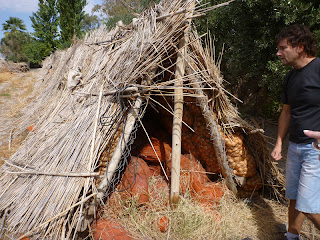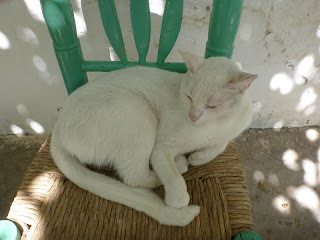Nous allons tous les quatre, les trois filles dorment toujours.
Sur la route, nous sommes doublés par des ambulances. Un peu plus loin, nous voyons un très grave accident. Une voiture est venue percuter de plein front un camion. Le camion est très abimé et la voiture, qui a roulé en contrebas, complètement démolie.
Nous arrivons à la finca. Elle produit du raisin mais la vendange vient juste d’être faite. La récolte, cette année a été de 60 000 kg. La petite maison est en mauvais état et inhabitée. Le papa de Fabiana a des plans de la retaper.
Ici, les plantes de vignes sont assez hautes et soutenues par des tuteurs. Les vendangeurs passent en desous et lèvent les bras pour cueillir le raisin. Il nous montre un grand récipient que les vendangeurs portent et remplissent de raisin. Il est en métal et est lourd même vide ! Un vendangeur le remplit, marche jusqu’au camion, monte sur un escabeau et verse le raisin dans le camion. On lui donne alors une fiche. A la fin de la journée, on compte ses fiches et il est payé 2 pesos par récipient. Un bon travailleur peut faire cent récipients par jour, 200 pesos (260 kr ou 32 €). Mais c’est un travail dur et saisonnier. Là aussi, il y a un système d’irrigation par canaux et la distribution d’eau est très contrôlée. Le papa de Fabiana nous donne du raisin. Un moscatel est particulièrement sucré et très bon. Merci à lui.
Nous allons ensuite voir une autre finca d’amis de Marcelo. C’est dans une autre partie, qui, fait rare autour de San Juan, a beaucoup d’eau. La nappe d’eau est très proche de la surface. La terre est appelée « tierra negra », terre noire et est très fertile. C’est là que sont produits tous les légumes de San Juan.
Une amie du frère de Marcelo, Estela, nous reçoit très gentiment. C’est son père qui exploite la finca. Ils produisent des tomates, des aubergines, des oignons. Mais les oignons, c’est pour la production de graines. Nous allons voir les tomates. Jens veut en manger une, mais Estela l’arrête. Il faut la laver, et même mieux, l’éplucher. Elles sont vaporisées de « poison », c’est le mot qu’elle emploie ! Et même avec tous les pesticides et herbicides, une partie des tomates est malade, toutes sèches et ils ne savent pas ce que c'est.
Ils ont des chevaux, un cochon. Et ce cochon, le papa d’Estela l’a trouvé sur le bord d’une route, tout petit. Il a demandé à qui il était mais personne ne savait alors il l’a rammené chez lui. Ils aiment les oiseaux et ont des paons, des poules, bien sûr, et des oiseaux en cage, plus un chat blanc et un chien blanc.
Ils nous donnent des tomates, des aubergines et des noix. Merci à eux.
Nous rentrons à San Juan et déjeunons tous les sept (nous quatre adultes plus les trois filles) d’un excellent … poulet farci que Marcelo et Jens vont chercher. Accompagné d’une salade et suivi de glace, c’est encore un bon repas.
Nous les quittons en les remerciant de cette bonne journée, c’est intéressant pour nous de visiter des fincas et de voir de plus près l’agriculture d’ici.
Fin de journée tranquille à l’hôtel.
Et, pour ceux que cela intéresse, le blog pour le voyage de Tucuman est mis à jour, texte et photos.
We have an appointment at 9:30 am with Fabiana and Marcelo. We leave the hotel at 9 am on our bikes. They invited us to go with them to the finca (farm) of Fabiana's father. It's outside of San Juan, at about 15 km. He does not live there. It has it in addition to his work.
We are the four of us, the three girls are still sleeping.
On the road, we are passed by ambulances. A little further, we see a very serious accident. A car came crashing head-on on a truck.The truck was severely damaged and the car, which rolled below, completely demolished.
We arrive at the finca. It produces grapes but the harvest has just been made. This year, the harvest was
60 000 kg. The cottage is in poor condition and uninhabited. Fabiana's father has plans to restore it.
He shows us a large container that harvesters fill with grapes. It is made of metal and is heavy even when empty! A grape picker fills it, walks to the truck, climbs a ladder and pours grape into the truck. He is given a little card. At the end of the day, the cards are counted and he is paid two pesos per container. A good worker can make a hundred containers a day, 200 pesos (260 kr or 32 €). But it is hard work and seasonal. Here, the wine is quite high. The pickers walk under it and has to lift the arms to pick the grape. Again, there is a system of irrigation canals and water distribution is strictly controlled. Fabiana's father gives us grapes. The moscatel is sweet and very good. Thank you to him.
We drive then to see another finca, owned by some friends of Marcelo. This is in another part, which, and this is rare around San Juan, has plenty of water. The water layer is very close under the surface. The earth is called "tierra negra" black earth and is very fertile. This is where all the vegetables are produced in San Juan.
Marcelo’s brother’s friend, Estela, receives us very kindly. It is her father who operates the finca. They produce tomatoes, eggplant, onions. But the onions, it is for seed production. We see the tomatoes. Jens wants to eat one, but Estela stops him. It should be washed, and even better, peeled. They are sprayed often with "poison", this is the word she uses! But even with the pesticides and the herbicides, a large part of the tomatoes are sick, all dried out. There is a disease, and they don't know what it is.
They have horses, a pig. Estela’s father found him on the roadside, as a tiny baby pig. He asked who was the owner but no one knew, so he took it home. They like birds and have peacocks, chickens of course, and caged birds, plus a white cat and a white dog.
They give us tomatoes, eggplant and walnuts. Thank you to them.
We returne to San Juan and lunch together at Marcelo and Fabiana's house, the seven of us (four of us adults, and the three girls) with an excellent ... stuffed chicken that Marcelo and Jens went to pick at the shop . With a good salad and followed by ice cream, it is again a very good meal.
We leave, thanking them for this good day, it was interesting for us to visit fincas and have a closer look at the local agriculture.
We spend the rest of the day quietly at the hotel.
And now, for those with time and interest, the blog for the Tucuman trip is updated, text and pictures.
La vieille maison de la finca
The old house at the finca
Les vignes
The wineyard
Un vieux four à Pain
An old bread oven
L'escabeau pour monter au camion
The ladder to climb to the truck
Une vieille charrue
An old plow
Une grape de moscatel
Moscatel grape
La deuxième finca, un champ de tomates
The second finca, a tomato field
La maison
The house
Des ouvriers trient les tomates
Workers are sorting the tomatoes
Paons et poules
Peacocks and hens
Le cochon adopté
The adopted pig
Les chevaux
The horses
L'eau qui est pompé du sol et va servir à irriguer
The water which is pumped from the soil and is used to irrigate
Les oignons qui vont être planter (pour récolter les graines)
The oignons, waiting to be planted (to harvest the seeds)
Oiseaux
Birds
Chat blanc
White cat
Chien blanc
White dog
Chez Marcelo et Fabiana: la mère et la fille
At Marcelo and Fabiana's house: mother and daughter
Déjeuner chez Marcelo et Fabiana
Lunch at Marcelo and Fabiana's house
Ceiba spesiosa




















No comments:
Post a Comment